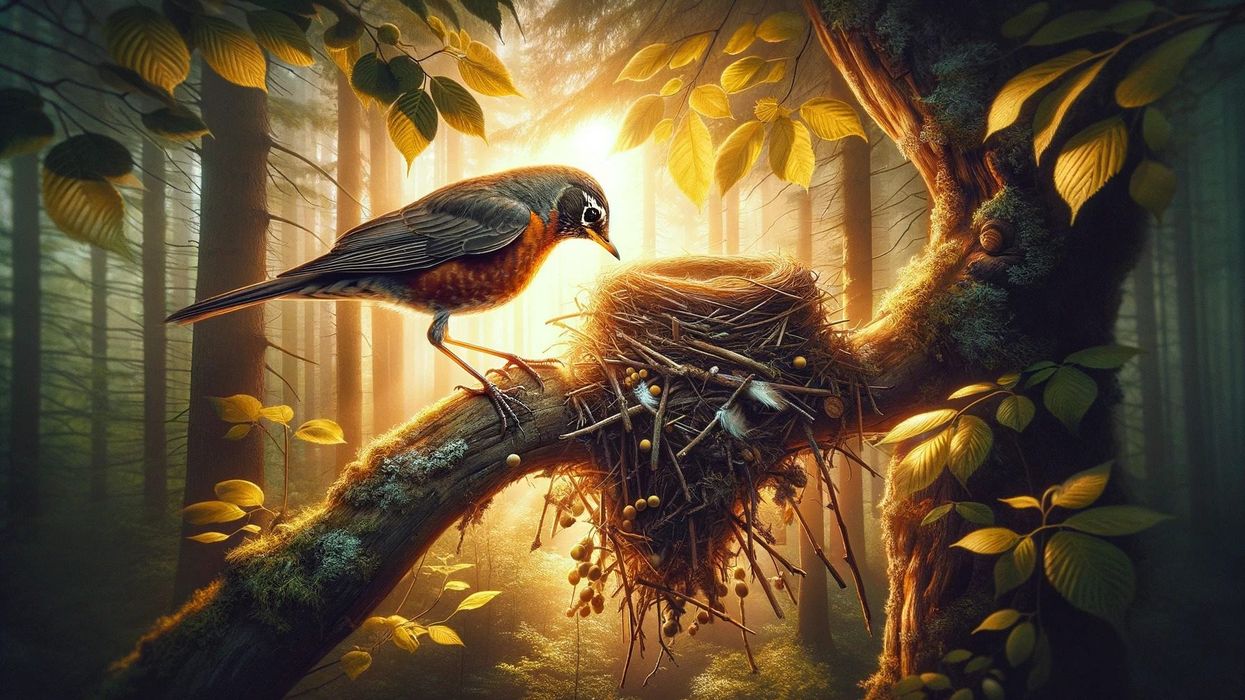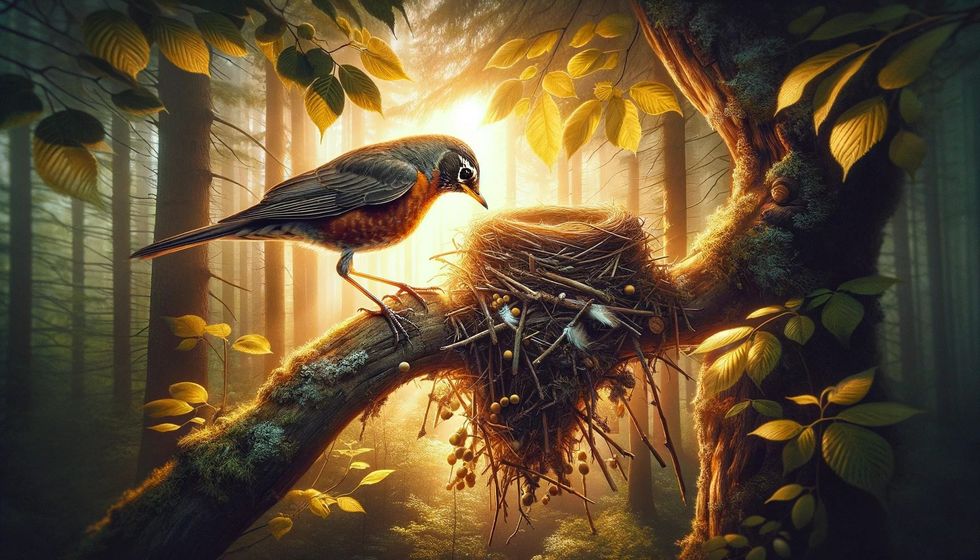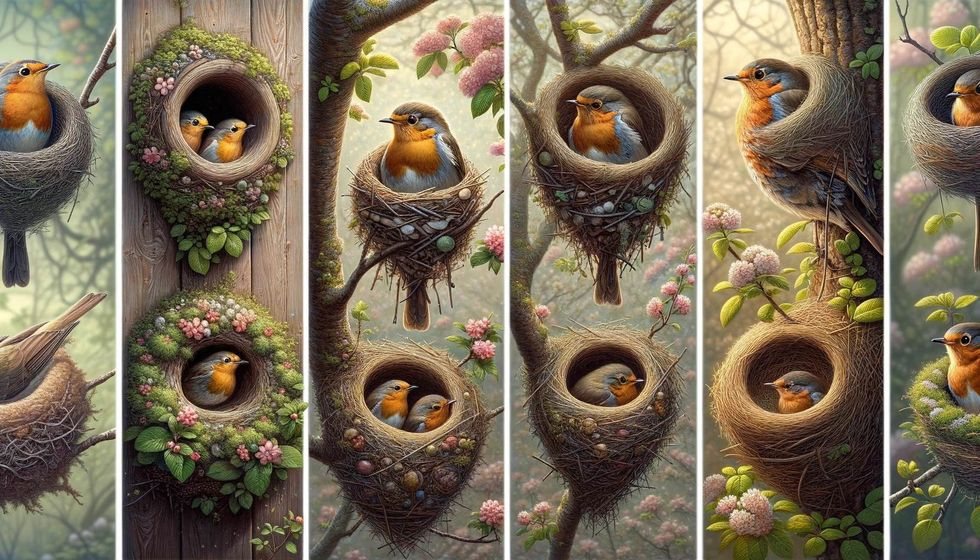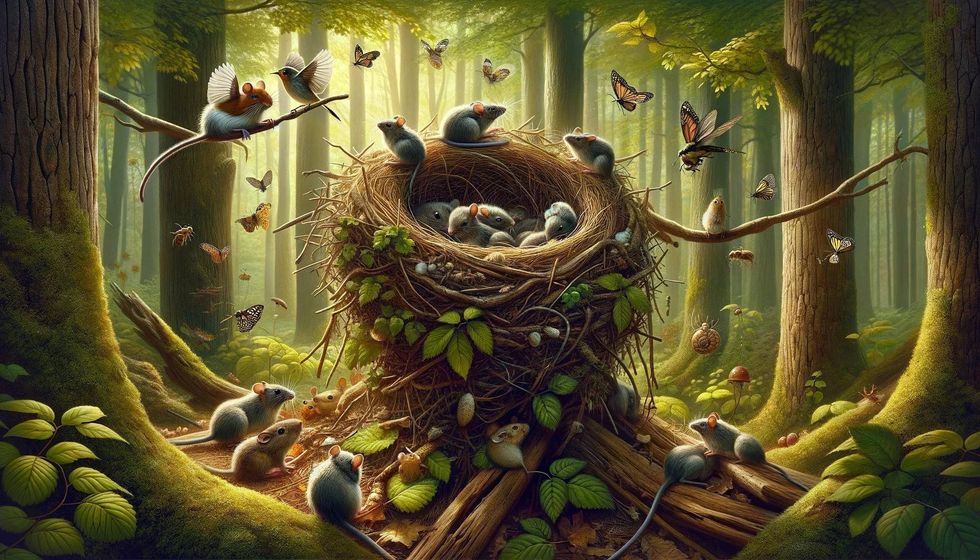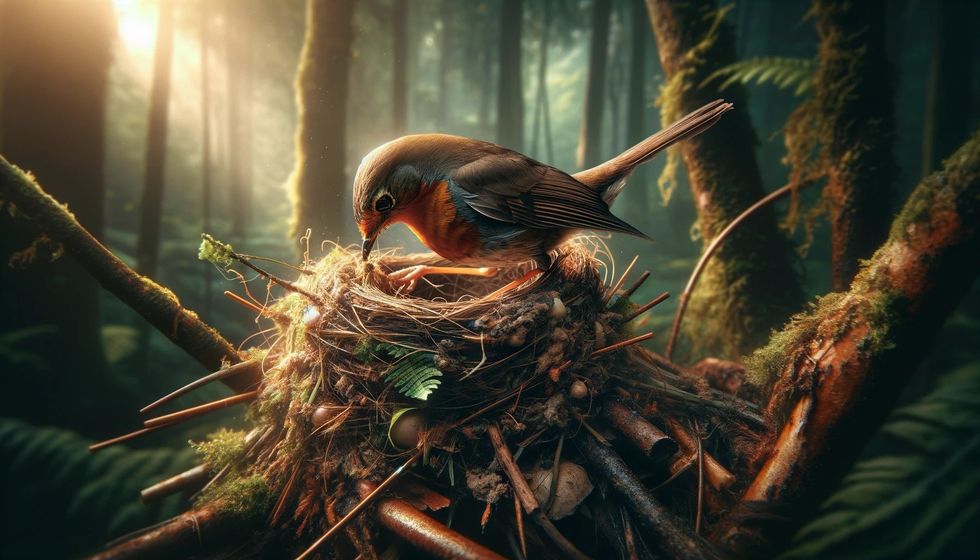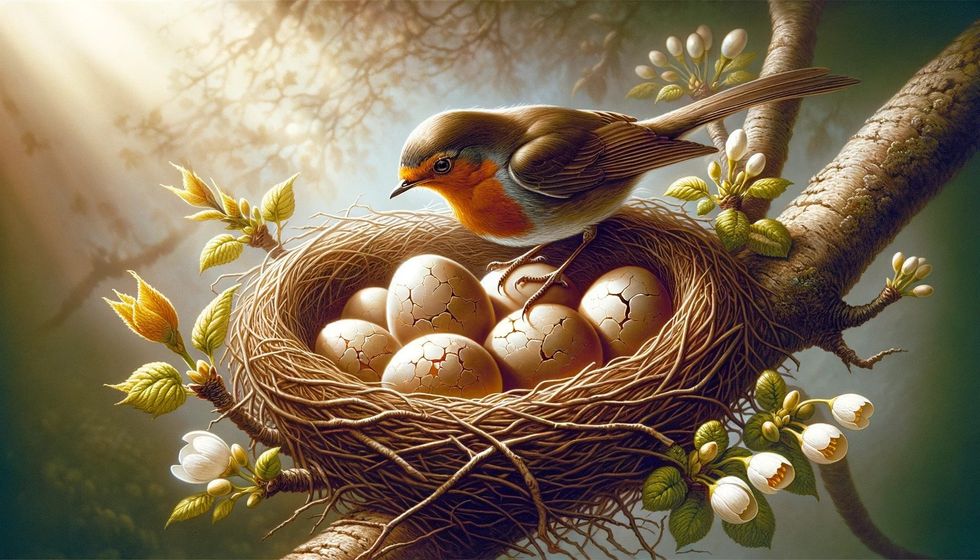Robins are fascinating birds, and their nesting habits are especially interesting. Did you know that robins are quite particular when making a home for their baby birds? A robin's nest is carefully built by both the male and female robin using grass, twigs, and mud. They often place their nest in sheltered areas, sometimes even in a nest box provided by humans. This cozy home is where they lay eggs and raise their baby robin until it's ready to venture out into the world.
However, after the hard work of raising their baby birds, do robins reuse their nests for the next batch of eggs? Typically, robins prefer to start fresh each year. This means the same robin or the same bird pair might build a new nest in a nearby location but rarely use the old one again. The main reason is hygiene and safety, as old nests can harbor parasites and diseases. But if a nest is particularly well-made and in a safe spot, a robin might decide to rebuild it with new nesting material for their next family.
Sometimes, you might find abandoned eggs in a robin nest. This might happen for several reasons, such as the eggs not hatching or the nest being disturbed. If robins feel their nest and eggs are in danger, they might abandon them to start anew elsewhere. This shows how adaptable and resilient American robin nests can be, ensuring the survival of their species. So, while they may not reuse their old nests, robins are experts at creating the perfect home for their young, time and time again.
Robins' Nest Reuse and Nesting Preferences

American robins are easily identified by their bright red chests and beautiful songs. Their nesting habits and preferences have always fascinated birdwatchers and researchers. Here are some key facts about how robins reuse their nests and their nesting preferences.
- American robins typically choose the crook of a tree or a sheltered part of a porch as their nesting locations. (Web, n.d.)
- The nests are constructed from mud, small twigs, and grass, forming a stable base for the robin eggs.
- A female robin will lay one egg daily until she completes her clutch, which is generally comprised of three to four eggs. (American Robin Nests and Eggs - NatureMapping, n.d.)
- It is not common for robins to reuse old nests from previous years; they prefer constructing a new nest for each breeding season. (Journal, 2018)
- Robins may return to the same nesting spot if it was a secure and successful location for raising their young in the past. (Herald, 2019)
- Old nesting materials are usually left behind as they could be infected with parasites that pose a threat to the baby robins. (05/16/2022 Nesting Season in Full Swing, n.d.)
- Nest building is primarily the female robin's responsibility, with the male providing some materials occasionally. (American Robin, n.d.)
- Robins are known to have two to three broods per year, with a new nest being constructed for each one.
- Nest sites are typically located 5-25 ft (1.5-7.6 m) above the ground and are concealed within dense foliage to safeguard against predators.
- Once the approximate five-week nesting period concludes, the nest is often abandoned due to parasite risks and the necessity for a clean and secure environment for upcoming broods. (Article: How to Build a Robin’s Nest, n.d.)
What happens to abandoned Robin nests?

Once the breeding season, is over and the young robins have flown away from the nest, it becomes empty and quiet. What happens to these empty robin nests is a fascinating part of their life cycle.
- Robins typically construct a new nest for each brood, avoiding the reuse of nests from prior breeding seasons. (The American Robin | Brandywine Conservancy and Museum of Art, 2020)
- Over time, abandoned robin nests may break down due to weather exposure, including rain, wind, and snow. (American Robin (Sankofa Wetland Park &Amp; Nature Trail) · iNaturalist, n.d.)
- Other bird species sometimes use deserted robin nests as rest spots or for gathering materials for their nest creation. (American Robin, n.d.)
- Robins, as well as other birds, can repurpose materials from old nests when building new ones. (Robin Nesting Habits: How to Find Nests & 5 Nest Behaviors to Observe, n.d.)
- Robins have been seen constructing fresh nests atop previous ones, especially in locales that have been safe and successful in the past. (American Robin, n.d.)
- Various insects, spiders, and small creatures may take up residence in unoccupied robin nests.
- The natural breakdown of unused nests contributes organic matter to the soil, playing a part in the nutrient cycle of the ecosystem.
- A robin pair may repeatedly return to the same overall nesting area across different years without using the same nest.
- If an emptied nest remains in good condition, it may be repurposed by the robin pair for subsequent broods within the same season.
- On rare occasions, a robin might build several nests at once; however, only one is typically used for the egg-laying and incubation process.
The Nest Building Process of Robins

Creating a comfortable home is a big job for robins. Building a nest takes a lot of work and time, but it's worth it to ensure that the eggs and young ones are safe. The female robin puts in a lot of effort to create a strong nest in a secure spot because it's important for her baby birds to stay safe and sound.
- Robins typically take two to six days to construct a nest, collecting materials and weaving them together to ensure the structure is strong. (Article: How to Build a Robin’s Nest, n.d.)
- Nest materials include twigs, mud, dry grass, and occasionally objects like string, ribbon, lichens, or moss. They start with coarse grass and twigs for the foundation, use mud to form an inner bowl and line it with fine grasses and plant fibers.
- Mud acts as a crucial binding agent to solidify the nest, much like cement. Robins source mud from puddles or make their own by moistening the soil. (Di Silvestro, 2023)
- The female robin is mainly responsible for nest construction, making many trips to gather materials. The male robin might assist but does not do much of the building.
- The average nest is about 6 in (15.2 cm) across and 4-6 in (10.1-15.2 cm) high, with an inner cup around 3.5-4 in (8.9-10.1 cm) wide. (Featherstone, 2024) Nests are usually placed 5-25 ft (1.5-7.6 m) off the ground in a tree or on man-made structures. (Foster, 2023)
- Though they rarely reuse their own nest, robins might build a new one on or near an old one if the site has been successful before. (2024)
- For added comfort and insulation, the female lines the inside of the nest with fine grasses and soft fibers.
- For each of the two to three broods they have each season, robins build a brand-new nest, with the first one going up early to take advantage of the evergreen vegetation's cover. (Featherstone, 2024)
- Robins fiercely protect their nests, attacking predators and possibly abandoning nests that get disturbed during construction.
- To maintain cleanliness and avoid attracting predators, robin nestlings produce fecal sacs, which the parents dispose of or sometimes consume. (Facts: Robin Nests, n.d.)
Understanding Robin Egg and Chick Development

The growth from a robin egg to a chick ready to leave the nest takes place in just several weeks. It's a series of natural steps and parental involvement that helps these birds grow and prepare to leave the nest. Knowing how robin chicks grow shows how these birds adapt and survive.
- Female robins incubate their eggs for 12-14 days, starting after the second egg is laid. (American Robin Life History, All About Birds, Cornell Lab of Ornithology, n.d.)
- A typical robin clutch consists of three to five eggs, with the potential for two to three broods each season.
- Robin eggs are known for their distinct pale blue color.
- Robin eggs measure about 1.1-1.2 in (2.8-3.0 cm) long and 0.8 in ( 2.0 cm) wide. (American Robin Life History, All About Birds, Cornell Lab of Ornithology, n.d.)
- Newly hatched robin chicks have minimal white down and yellowish, translucent skin with closed eyes. (Samurovic, 2024) Within a week, their eyes start to open, their feathers grow, and their parents feed them pre-digested food. (2023)
- After day 4, the chicks' diet shifts to whole insects, worms, spiders, and some fruits, fed to them dozens of times a day.
- Around 14-16 days post-hatching, fledglings are ready to leave the nest, despite their limited flying ability.
- Once they've fledged, robin parents provide care for another two to four weeks, with the male taking the lead as the female prepares for another brood.
- Juvenile robins display spotted brown plumage, gaining their adult red breast after a partial molt in late summer at about two to three months old.
- Survival rates are low; only 40% of eggs typically produce fledglings, and about 80% of juveniles don't survive their first year, with predation being a significant threat. The average lifespan of a robin is around two years. (How Long Does It Take for Robin Eggs to Hatch?, 2019)
Comparing Nest Habits Across Bird Species

Birds have different ways of building nests and taking care of their eggs and chicks. They choose different places and materials for their nests, showing a lot of variety in their behaviors. By looking at these various methods, we can learn about how each species adapts and survives.
- Robins typically build a new cup-shaped nest for each brood, while some birds, like eagles and storks, may reuse the same large nest structure for many years. (2023)
- Robins construct nests from grass, twigs, and mud, but materials used by other birds include sticks, moss, lichen, fur, saliva, and even human-made items like plastic and paper.
- The female robin does most of the nest building, while in some species, like wrens and penguins, the male is the primary nest builder. (2023)
- Robins lay 3-5 eggs per clutch, but clutch sizes in other species range from 1 egg (condors) to over 20 (some game birds).
- Robin eggs are blue, while the egg colors of other species span a wide spectrum, including white, brown, spotted, and even turquoise. (Davis, 2021)
- Both male and female robins provide parental care, but in some species, like hummingbirds and phalaropes, only one parent cares for the young. (What Is Clutch Size and Why Do We Study It? - NestWatch, 2021)
- Robins have adapted to nesting on human-made structures, as have barn swallows, peregrine falcons, and some swifts. However, many other species still rely on natural nesting sites and are negatively impacted by habitat loss.
- Unlike robins, some birds, like murres and penguins, don't construct nests at all and instead lay their eggs directly on cliff ledges or bare ground.
FAQs
Do robins build a new nest for each brood?
Yes, American robins typically construct a new nest for each brood within a breeding season. While they might repair or build on top of a previous nest, most choose to start anew. This practice is beneficial for several reasons, including avoiding parasites and ensuring a stable structure for their eggs and chicks.
How many eggs do robins usually lay?
Robins usually lay three to four eggs per clutch during their first nesting of the season. It's rare, but sometimes they can lay up to five eggs.
How long does it take for robin eggs to hatch?
After the female robin begins incubation, which usually starts after laying the second egg, it takes about 12-14 days for the eggs to hatch.
Robins have a habit of going back to places where they had successful nests before and building new ones there. They don't actually reuse their old nests, but they definitely like to stick to what works! Robins have a clever habit called nest-site fidelity. This means they stick to nesting in places they know are good, where they can find enough food, and shelter, and stay safe from predators.
Related Articles Around the Web

